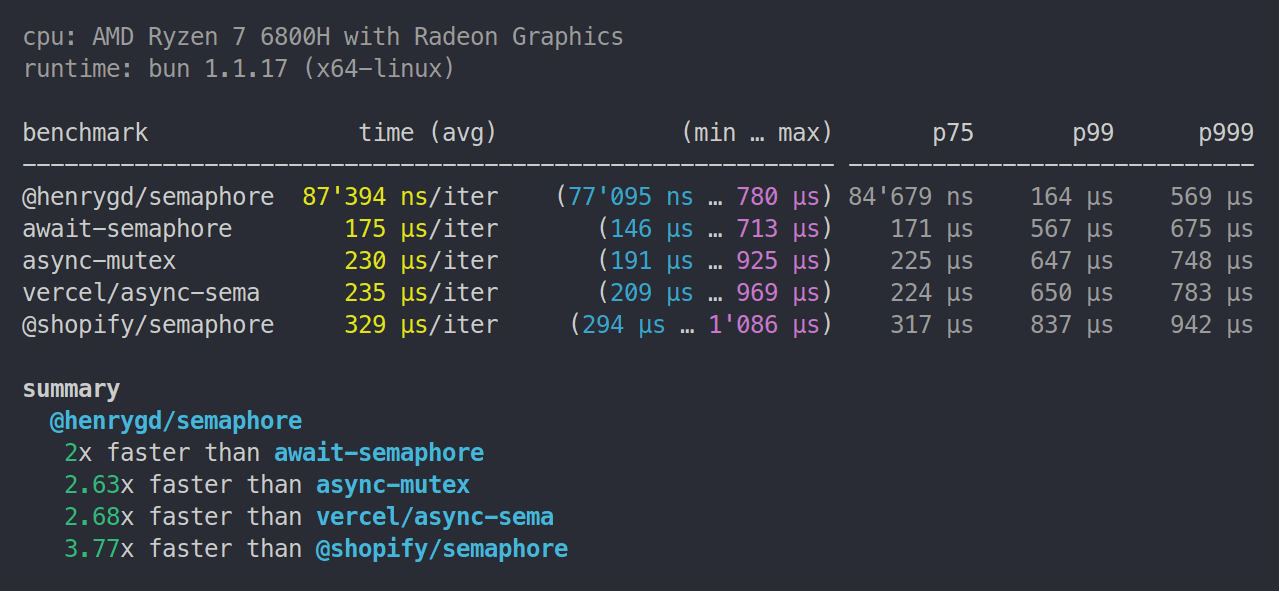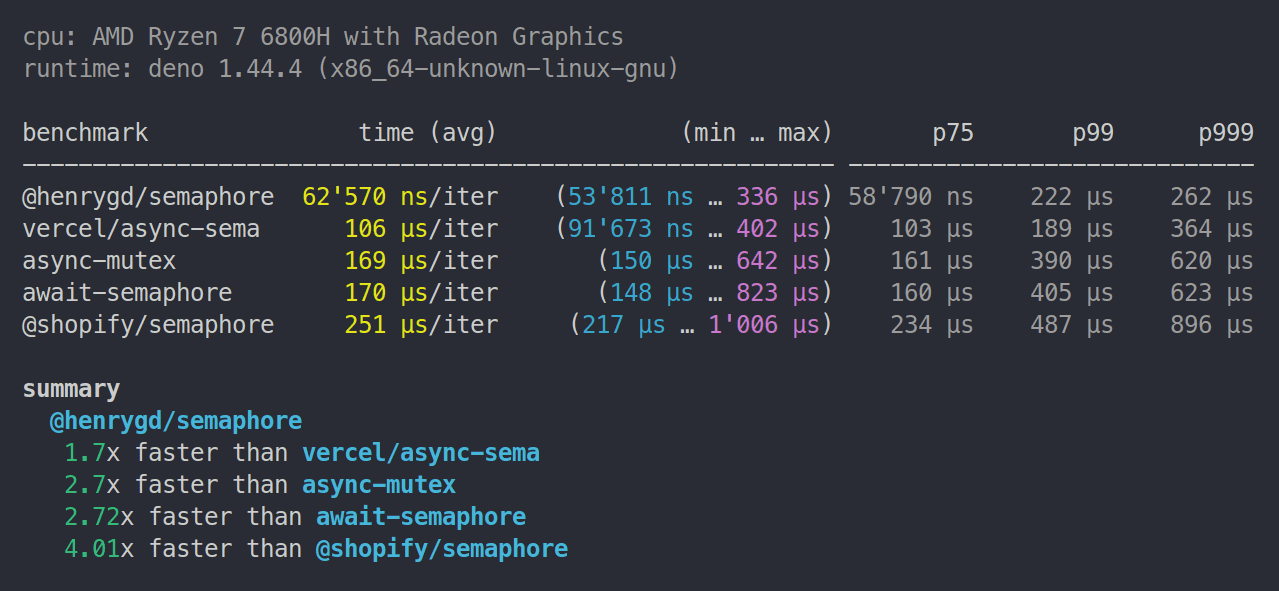https://github.com/henrygd/semaphore
Faster inline semaphores and mutexes in javascript
https://github.com/henrygd/semaphore
async async-await concurrency mutex promise semaphore
Last synced: 8 months ago
JSON representation
Faster inline semaphores and mutexes in javascript
- Host: GitHub
- URL: https://github.com/henrygd/semaphore
- Owner: henrygd
- License: mit
- Created: 2024-06-27T23:55:40.000Z (over 1 year ago)
- Default Branch: main
- Last Pushed: 2024-06-30T20:13:29.000Z (over 1 year ago)
- Last Synced: 2024-10-06T23:35:12.134Z (over 1 year ago)
- Topics: async, async-await, concurrency, mutex, promise, semaphore
- Language: TypeScript
- Homepage:
- Size: 31.3 KB
- Stars: 20
- Watchers: 1
- Forks: 0
- Open Issues: 0
-
Metadata Files:
- Readme: readme.md
- License: LICENSE
Awesome Lists containing this project
README
[size-image]: https://img.shields.io/github/size/henrygd/semaphore/dist/index.min.js?style=flat
[license-image]: https://img.shields.io/github/license/henrygd/semaphore?style=flat&color=%2349ac0c
[license-url]: /LICENSE
# @henrygd/semaphore
[![File Size][size-image]](https://github.com/henrygd/semaphore/blob/main/dist/index.min.js) [![MIT license][license-image]][license-url] [](https://jsr.io/@henrygd/semaphore)
Fast inline semaphores and mutexes. See [comparisons and benchmarks](#comparisons-and-benchmarks).
Semaphores limit simultaneous access to code and resources (e.g. a file) among multiple concurrent tasks.
Works with: 




## Usage
Create or retrieve a semaphore by calling `getSemaphore` with optional key and concurrency limit.
```js
const sem = getSemaphore('key', 1)
```
Use the `acquire` and `release` methods to limit access.
```js
await sem.acquire()
// access here is limited to one task at a time
sem.release()
```
## Full example
We use semaphores here to prevent multiple requests to an API for the same resource.
The first calls to `fetchPokemon` will acquire access to the protected code. Subsequent calls will wait, then return the data from the cache.
We use a key to allow access based on the name. This lets `ditto` and `snorlax` run simultaneously.
```js
import { getSemaphore } from '@henrygd/semaphore'
const cache = new Map()
for (let i = 0; i < 5; i++) {
fetchPokemon('ditto')
fetchPokemon('snorlax')
}
async function fetchPokemon(name) {
// get semaphore with key based on name
const sem = getSemaphore(name)
// acquire access from the semaphore
await sem.acquire()
try {
// return data from cache if available
if (cache.has(name)) {
console.log('Cache hit:', name)
return cache.get(name)
}
// otherwise fetch from API
console.warn('Fetching from API:', name)
const res = await fetch(`https://pokeapi.co/api/v2/pokemon/${name}`)
const json = await res.json()
cache.set(name, json)
return json
} finally {
// release access when done
sem.release()
}
}
```
## Interface
```ts
/**
* Creates or retrieves existing semaphore with optional key and concurrency level.
*
* key - Key used to identify the semaphore. Defaults to `Symbol()`.
* concurrency - Maximum concurrent tasks allowed access. Defaults to `1`.
*/
function getSemaphore(key?: any, concurrency?: number): Semaphore
interface Semaphore {
/** Returns a promise that resolves when access is acquired */
acquire(): Promise
/** Release access to the semaphore */
release(): void
/** Returns the total number of tasks active or waiting for access */
size(): number
}
```
### Keys and persistence
Keyed semaphores are held in a `Map` and deleted from the `Map` once they've been acquired and fully released (no waiting tasks).
If you need to reuse the same semaphore even after deletion from the `Map`, use a persistent variable instead of calling `getSemaphore` again.
### Concurrency
Concurrency is set for each semaphore on first creation via `getSemaphore`. If called again using the key for an active semaphore, the concurrency argument is ignored and the existing semaphore is returned.
## Comparisons and benchmarks
Note that we're looking at libraries which provide a promise-based locking mechanism, not callbacks.
| Library | Version | Bundle size (B) | Keys | Weekly Downloads |
| :--------------------------------------------------------------------- | :------ | :-------------- | :--- | :--------------- |
| @henrygd/semaphore | 0.0.1 | 267 | yes | ¯\\\_(ツ)\_/¯ |
| [async-mutex](https://www.npmjs.com/package/async-mutex) | 0.5.0 | 4,758 | no | 1,639,071 |
| [async-sema](https://www.npmjs.com/package/async-sema) | 3.1.1 | 3,532 | no | 1,258,877 |
| [await-semaphore](https://www.npmjs.com/package/await-semaphore) | 0.1.3 | 1,184 | no | 60,449 |
| [@shopify/semaphore](https://www.npmjs.com/package/@shopify/semaphore) | 3.1.0 | 604 | no | 29,089 |
> If there's a library you'd like added to the table or benchmarks, please open an issue.
## Benchmarks
All libraries run the same test. Each operation measures how long it takes a binary semaphore with 1,000 queued `acquire` requests to allow and release all requests.
### Browser benchmark
This test was run in Chromium. Chrome and Edge are the same. Safari is more lopsided with Vercel's `async-sema` dropping to third. Firefox, though I love and respect it, seems to be hard capped by slow promise handling, with `async-mutex` not far behind.
You can run or tweak for yourself here: https://jsbm.dev/8bBxR1pBLw0TM

> Note: `await-semaphore` is extremely slow for some reason and I didn't want to include it in the image because it seems excessive. Not sure what's happening there.
### Node.js benchmark

### Bun benchmark

### Deno benchmark

### Cloudflare Workers benchmark
Uses [oha](https://github.com/hatoo/oha) to make 1,000 requests to each worker. Each request creates a semaphore and resolves 5,000 acquisitions / releases.
This was run locally using [Wrangler](https://developers.cloudflare.com/workers/get-started/guide/). Wrangler uses the same [workerd](https://github.com/cloudflare/workerd) runtime as workers deployed to Cloudflare, so the relative difference should be accurate. Here's the [repo for this benchmark](https://github.com/henrygd/semaphore-wrangler-benchmark).
| Library | Requests/sec | Total (sec) | Average | Slowest |
| :----------------- | :----------- | :---------- | :------ | :------ |
| @henrygd/semaphore | 941.8135 | 1.0618 | 0.0521 | 0.0788 |
| async-mutex | 569.5130 | 1.7559 | 0.0862 | 0.1251 |
| async-sema | 375.7332 | 2.6615 | 0.1308 | 0.1818 |
| @shopify/semaphore | 167.8239 | 5.9586 | 0.2925 | 0.4063 |
| await-semaphore\* | n/a | n/a | n/a | n/a |
> \* `await-semaphore` does not work with concurrent requests.
## Related
[`@henrygd/queue`](https://github.com/henrygd/queue) - Tiny async queue with concurrency control. Like p-limit or fastq, but smaller and faster.
## License
[MIT license](/LICENSE)